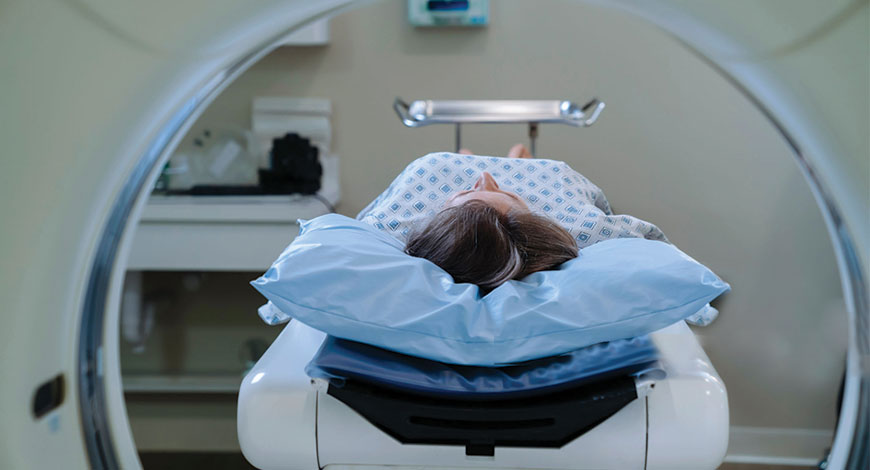CT Scanners
The changing face of radiology

The advent of computed tomography has revolutionized radiology, and this revolution is still underway.
Since CT’s inception in the 1970s, radiologists and medical providers alike have witnessed the technology’s great benefits, including reducing the length of hospitalizations, improving cancer diagnosis and treatment, and determining when surgeries are needed. In 2021, the technology is being leveraged as part of the standard of care process for another important use case—diagnosing COVID-19.
Starting as a pure head scanner, modern CT systems are now able to perform whole-body examinations within a couple of seconds in isotropic resolution, single-rotation whole-organ perfusion, and temporal resolution to fulfill the needs of cardiac CT. Because of the increasing number of CT examinations in all age groups and overall medical-driven radiation exposure, dose reduction remains a hot topic. Although fast gantry rotation, broad detector arrays, and different dual-energy solutions were main topics in the past years, new techniques such as photon counting detectors, powerful X-ray tubes for low-kV scanning, automated image preprocessing, and machine learning algorithms have moved into focus today.
The COVID-19 pandemic has raised a need for faster diagnosis and treatment of diseases. Industry players associated with medical device manufacturing are working aggressively to meet the emerging of needs healthcare providers for better imaging solutions, augmenting the market growth globally.
The size of the global CT scanners market is estimated to reach USD 8.2 billion by the end of 2024, at a CAGR of 4.54 percent, predicts Market Data Forecast. With the advent of high-speed and multi-slice CT scanners, healthcare providers have changed their approach to imaging, diagnosis, and treatment of patients as new ways for clinical applications in such areas as trauma, vascular, pediatric, and cardiac imaging are possible due to the higher speeds at which scanning can be done. Rapidly growing demand for bedside imaging, home healthcare, and growing use of CT scan to assess the accuracy of post-interventional medical procedures, medical implants, and anatomical confirmation are some of the main factors driving industry growth.
CT technology has evolved from first-generation to advancements like cone beam CT, multi-detector CT, higher slice system, new detector technology, spectral CT imaging, data integration, dual source scanner, and dual energy. The advent of third generation CT scanner typically having higher number of detectors gives high resolution images and resultant increase in the pickup of the abnormality. Multi-detector CT scans helps in reducing the radiation burden to the patient especially those requiring multiple studies. Multi-detector CT scanner reduces the acquisition time and improves the patient compliance during the scan and reduces waiting period.
High-slice CT scanners offer advanced imaging capabilities, with as many as 128, 256, 320, or more slices in a single rotation. These devices offer advanced capabilities for cardiac and vascular imaging as well as cancer diagnosis and treatment. Market growth is mainly driven by the ongoing commercialization of advanced products across major markets, increasing public-private investments in the field of high-slice CT, and growing emphasis on effective and early disease diagnosis and treatment. Moreover, advanced CT imaging capabilities offered by high-slice CT devices and their growing adoption for out-patient diagnostic procedures have expanded their application horizons.
Mid-slice CT scanners offer 32- and 64-slice capabilities in a single rotation. As compared to low-slice CT scanners, these acquire images much faster and feature significant diagnostic accuracy and a larger application base (such as detection of coronary stenosis, kidney stones, appendicitis, and spinal stenosis). The growth in the CT scanner market is expected to be propelled by factors such as availability of significant clinical data to validate clinical efficacy of 64-slice CT scanners in cardiology, vascular imaging, and neurology applications; growing adoption of 64- & 32-slice CT devices in oncology, trauma, and critical care; ongoing technological advancements in this field; and modernization of healthcare infrastructure and services across emerging countries.
Low-slice CT scanners offer single-plane CT imaging or multi-slice imaging capabilities with 4, 8, or 16 slices in a single rotation. These include multi-slice CT devices and conventional CT scanners. Market growth for low-slice CT is driven by the significant use of these scanners for major clinical applications (such as pulmonary imaging, urological imaging, intra-operative imaging, and image-guided surgical procedures), large installation base for low-slice CT scanners across major healthcare markets, affordable product pricing (as compared to medium- & high-slice devices), and greater market preference for low-slice devices across emerging countries (due to the optimal imaging capabilities, need of limited operational skills, and product affordability).
Cone beam CT scanners use a single or multiple X-ray sources that focus on the target area, forming a focused cone beam. These devices are used for specific applications in the fields of dentistry, endodontics, maxillofacial surgeries, and otolaryngology, among others. The growing market demand for CBCT scanners can be attributed to the increasing applications of CBCT technology in human diagnostic applications (such as dental implants, maxillofacial surgeries, and neck surgeries), procedural advantages offered by CBCT (such as limited radiation exposure, affordable product costs, and low scanning time), rising market demand for cosmetic dentistry & aesthetic procedures (coupled with the rising trend of medical tourism across emerging countries), and ongoing product development and commercialization of innovative CBCT devices across major healthcare markets.
In recent years, much work has been done to improve upon CT, but there are more innovations on the way that will impact providers and augment patient care. CT contributes roughly two-thirds of the total population dose in medical imaging, so it is the modality one need to focus their efforts on in terms of radiation protection. The growing use of CT means experts must take steps and make sure they are conscious of radiation dose.
In the coming years photon counting detectors – an emerging technology focused on radiation dose-efficiency, high spatial resolution, and energy discrimination – will revolutionize CT practice. The technology is still in the research stage, but it is currently being tested at the Mayo Clinic with results that have shown an 80-percent dose reduction.
In addition, there will be other advancements in filters that will help remove softer energy radiation from X-ray beams. When it comes to region-of-interest imaging, technology is under development to change the shape of CT beams to target specific organs, limiting the amount of radiation dose patients receive. It can be particularly useful with certain types of scans, such as cardiac CT.
 Dr Mona Bhatia
Dr Mona Bhatia
Director and Head Department of Radiology & Imaging,
Fortis Escorts Heart Institute
“With growing spectral and monoenergetic CT technology, vascular, perfusion, and contrast enhancement are adding new vistas, raising the bar of CT closer to MRI as the one stop shop for imaging. Current generation detectors use a two-step process to convert the incoming X-ray intensity into an electronic signal. New detector materials are now being developed which will directly convert each individual X-ray or photon into a small electrical current. The strength of the current reflects the energy of the individual photon. Therefore, these detectors are also called photon counting detectors or energy resolving detectors. Potentially, these new detectors have many advantages. Since they eliminate intermediate steps, they are more dose efficient than today’s detectors and add multienergy information to any CT scan with significantly higher spatial resolution. The images of CT with change forever and this disruptive technology holds the crystal ball of the future CT scans”
Hopefully, filters will allow limiting the exposure of adjacent organs that are not of clinical interest. Breast and lung tissue are two of the most radiosensitive areas in the body, and in a cardiac CT, they are exposed to the same high dose as the cardiac tissue even though we do not look at those images.
There are also several things radiologists can do to maximize dose optimization technologies currently available on most CT scanners. For example, they should lower the kilovoltage, particularly for angiographic exams, and they should monitor routine dose levels to identify errant practices. Additionally, based on clinical need, they can use clinical indication-based CT protocols to individualize radiation dose.
Alongside technological advancements and strategies to optimize existing technologies, there are other things providers can do to control radiation dose. In addition to following appropriateness guidelines for conducting scans, it is also important to remember that radiation dose is not standardized from one facility to another. According to an article published last year in the British Journal of Radiology, average CT doses can range between 4-to-17 fold based on practice preferences and protocols. Being aware of what other facilities do can help control radiation exposure if patients switch between settings for scans. Dose monitoring is important, and experts have access to automated dose-monitoring software.
The continued CT advancements will encourage departments and practices to give everyone – not just one person – shared responsibility for keeping tabs on doses related to CT and other modalities.
 Dr Rajesh Jawale
Dr Rajesh Jawale
HOD and Senior Consultant Radiologist,
Wockhardt Hospitals
“The COVID-19 pandemic has spiked the demand for CT scan equipment. Many new buyers may not have enough detailed knowledge of physics involved in the CT Technology. There is a general belief that more slices means better image quality. But, there are several other parameters worth consideration while buying the CT scanners. Other than the number of slices, few important key features of the CT include the rotation time of the gantry, which translates into a faster temporal resolution to reduce motion blur. Presently, CT scanner with the 64 slice acquisition and 128 slice reconstruction has become the minimum standard for the centers doing a good number of CT coronary angiography. However, I would suggest considering the cost verses benefit when looking at a higher slice machine as it costs significantly more and may incur high maintenance”
An important new trend is photon counting CT (PCCT) technology, which has the potential to define a new standard of performance for premium CT systems for many years to come. PCCT has the promise to further expand the clinical capabilities of traditional CT, including the visualization of minute details of organ structures, improved tissue characterization, more accurate material density measurement or quantification, and lower radiation dose. This technology, which is currently still under development, will be a hot topic in 2021 and beyond.
COVID-19 and the events of 2020 will have an effect on healthcare for decades to come. Last year highlighted the need for simple and fast workflows to allow clinicians and staff more time to care for patients, but it also highlighted the importance of listening to and rapidly responding to customer needs.
CT systems will continue to be upgraded and inherit technologies that provide unparalleled precision and accuracy for fast decision making and a streamlined workflow.












